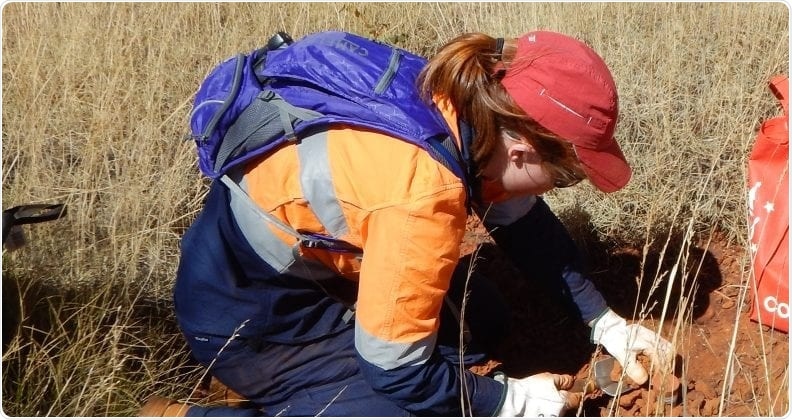Next-generation DNA sequencing has been used by Curtin University scientists to gain a deeper understanding of different species of animals, insects, and plants existing in the Perth and Pilbara parts of Western Australia.

Curtin PhD Candidate Ms Mieke van der Heyde collecting samples for eDNA analysis. Image Credit: Curtin University.
Mieke van der Heyde, lead researcher and Ph.D. candidate from Curtin University and from the ARC Centre for Mine Site Restoration, stated that within the biological monitoring space, DNA metabarcoding is an emerging field and has the potential to facilitate precise, rapid, and low-cost assessments of biodiversity.
Traditionally, biomonitoring has relied on scientists setting traps and visually monitoring a certain area, counting the number of species, and then extrapolating that data to come up with regional analysis.”
Mieke van der Heyde, Lead Researcher and PhD Candidate, Curtin University
Ms van der Heyde continued, “Understandably, that method of data collecting is expensive, time-consuming and challenging, especially when looking into remote areas of Australia, which often present a harsh climate. As animals and organisms interact with their environment, they leave behind traces of their DNA through things like droppings, skin cells, saliva, and pollen. When this DNA is found in the environment, it’s known as environmental DNA or eDNA.
“Our research looked into the feasibility of using this eDNA as an additional tool for biomonitoring. Not only to see if this type of analysis could potentially make things a bit easier for biologists out in the field but as well as providing researchers with more accurate field information then what they can visually identify,” Ms van der Heyde added.
The researchers assessed samples of a plant, soil, insect material, and animal droppings, collectively called “substrates,” obtained from two different regions of Western Australia—the Swan Coastal Plain, a hot Mediterranean-type climate, and the Pilbara, a hot desert climate.
We tested common environmental substrates including soil, bulk scat, bulk plant material, and bulk arthropods from pitfall traps and vane traps, using four eDNA barcoding assessments to detect a wide range of plants, vertebrates and arthropods. This study was the first of its kind to systematically test terrestrial substrates for eDNA, and it also was the first time that some of these particular substrates were analysed.”
Mieke van der Heyde, Lead Researcher and PhD Candidate, Curtin University
Ms van der Heyde added, “Results show that bulk arthropods and animal droppings detected the most biodiversity, with at least a third of the biodiversity detected in only one substrate. Soil samples detected the least, and fewer samples had usable DNA, especially in the Pilbara. We believe this is most likely due to the hot climate, which potentially degraded the eDNA.”
Biomonitoring is necessary for effective ecosystem management. Our study shows that eDNA can detect biodiversity in an area, and collecting more substrates will increase the breadth of biodiversity detected. However, surveys must be carefully considered, as DNA may come from organisms outside the study area.”
Mieke van der Heyde, Lead Researcher and PhD Candidate, Curtin University
The study titled “Testing multiple substrates for terrestrial biodiversity monitoring using environmental DNA (eDNA) metabarcoding” was published in the Molecular Ecology Resources journal.
The study was concluded at the Trace and Environmental DNA (TrEnD) Laboratory at the Perth campus of Curtin University.
Source:
Journal reference:
Van der Heyde, M., et al. (2020) Testing multiple substrates for terrestrial biodiversity monitoring using environmental DNA metabarcoding. Molecular Ecology Resources. doi.org/10.1111/1755-0998.13148.